Space heaters are a popular way to provide supplemental heating in homes and offices, but their high power requirements can make them a potential fire hazard if not used properly. One common question is whether a space heater can be safely plugged into a power strip, and the answer is generally no.
The Dangers of Plugging a Space Heater into a Power Strip
Space heaters typically draw between 1,500 and 3,000 watts of power, which is significantly more than the average household appliance. Most power strips and extension cords are not designed to handle this level of power consumption, and doing so can lead to several dangerous consequences:
-
Overheating and Fire Risk: When a high-wattage space heater is plugged into a power strip, it can cause the strip to overheat, potentially leading to melting, sparks, or even a fire. Power strips are not built to handle the sustained high current draw of a space heater.
-
Tripping Circuit Breakers: The high power draw of a space heater can easily overload a power strip’s circuit, causing the breaker to trip and potentially disrupting power to other devices on the same circuit.
-
Electrical Hazards: Overloading a power strip can also create electrical hazards, such as exposed wires or a malfunctioning strip that could deliver an electric shock.
According to the Electrical Safety Foundation International (ESFI), heating equipment, including space heaters, is the second leading cause of house fires in the U.S., with an estimated 65,000 fires caused by them each year. Space heater fires most often occur when they are plugged into a power strip.
Recommended Practices for Using Space Heaters

To use a space heater safely, the U.S. Consumer Product Safety Commission (CPSC) and other federal agencies recommend the following:
-
Plug the space heater directly into a wall outlet: Space heaters should always be plugged directly into a grounded, wall-mounted electrical outlet. Do not use extension cords or power strips, as they may not be able to handle the high current draw.
-
Ensure the outlet can handle the load: Check the space heater’s power requirements and make sure the outlet can safely accommodate the load. Most standard household outlets are rated for 15-20 amps, while space heaters can draw up to 15-20 amps.
-
Use a space heater with safety features: Look for space heaters with features like automatic shut-off, tip-over protection, and overheat protection to reduce the risk of fire.
-
Keep the space heater away from flammable materials: Maintain a safe distance of at least 3 feet between the space heater and any combustible materials, such as curtains, furniture, or bedding.
-
Never leave a space heater unattended: Always unplug the space heater when not in use and never leave it running while sleeping or away from home.
Alternatives to Power Strips for Space Heaters
If you need to use a space heater in a location without a nearby wall outlet, there are a few alternatives to consider:
-
Dedicated circuit: Consider having an electrician install a dedicated electrical circuit for the space heater, which will ensure the circuit can handle the high power draw.
-
Heavy-duty extension cord: If a wall outlet is not available, use a heavy-duty, grounded extension cord that is rated for the space heater’s power requirements. Make sure the cord is not coiled or covered, as this can cause overheating.
-
Portable power station: Some high-capacity portable power stations or generators may be able to safely power a space heater, but be sure to check the power ratings and follow the manufacturer’s instructions.
In summary, it is not recommended to plug a space heater into a power strip due to the significant fire and electrical hazards. Space heaters should always be plugged directly into a grounded wall outlet that can safely handle the high power draw. By following proper safety guidelines, you can use a space heater effectively and reduce the risk of a potentially devastating fire.
References:
- Reddit, “Why is plugging a space heater into a power strip hazardous?”, https://www.reddit.com/r/electrical/comments/sv2694/why_is_plugging_a_space_heater_into_a_power_strip/
- Realtor.com, “Space Heaters and Other Things You Shouldn’t Plug Into a Power Strip or Extension Cord”, https://www.realtor.com/advice/home-improvement/space-heaters-things-you-shouldnt-plug-into-a-power-strip-or-extension-cord/
- Raynor Services, “Prevent Power Strip Problems: 3 Reasons Why You Should Never Plug Your Space Heater Into a Power Strip”, https://raynorservices.com/prevent-power-strip-problems-3-reasons-why-you-should-never-plug-your-space-heater-into-a-power-strip/
- YouTube, “Verify | Do space heaters catch fire if you plug it into a power strip?”, https://www.youtube.com/watch?v=g5L5i9FpJQ8
